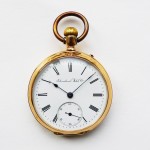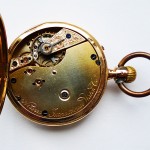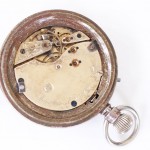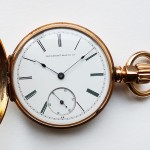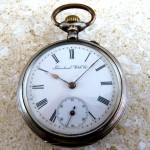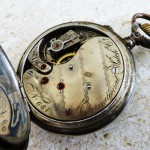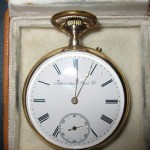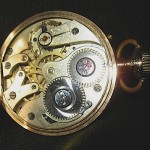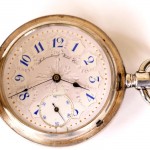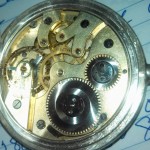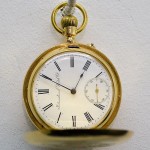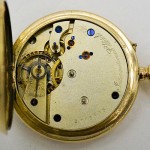Seeland’s management strategy failed in 1879, and in 1880 IWC was purchased at auction by a Schaffhausen industrialist, Johannes Rauschenbach-Vogel. This began a new era of movements, but in many ways IWC entered its own Dark Ages for the next several years. The original records for these movements, generally produced in very low quantities, do not exist until around 1884.
After Seeland movements, the first were Calibres 28 and 29, known as à bascule pilier. These were followed with a series of “Elgin” movements, beginning with Elgin I (Calibres 32, 33. 34 and 35). No one knows why these movements are called “Elgin”, and there is no known affiliation with the well-know American pocket watch manufacturer Elgin. The later Elgin movements, such as the Calibre 38 and 39 examples below, are a different design and very similar to the 1884 Elgin II “digital” Pallweber movements.
Shown here is a Pfister “à bascule pilier” Calibre 28. These movements were made from 1879 until about 1884. The Calibre 28 looks very much like the Seeland Calibre 22, with a three-quarters top plate, similar balance cock engraving, case and dial. The French term à bascule pilier can be translated into “rocking pillars” but in context “pillar plate work with rocking-bar keyless mechanism” .
The Calibre 29 is a much less common Savonette or hunter version of “à bascule pilier”. This example shows a poor condition case, but the movement is difficult to find. The Lepine (open face) version (calibre 28) starts with the special serial number 100,001 while the Savonette begins at 110,000.
Calibre 33, and its companion Lepine Calibre 32, are typical examples of Elgin I IWC movements made from 1879 to possibly 1886. Some have intricate balance cock engravings as shown here, but not all. One source reports that only about 230 Calibre 32 movements were made, but the quantity presumably is larger since records do not exist prior to 1884.
This Calibre 34, an Elgin I with hidden winding wheels, is very rare. There are less than 10 known examples, and all have movement numbers under 700 (in the so-called “second numbering”, starting in 1884).
This Calibre 38 is an example of an Elgin II, and the design visually differs from the Elgin I. Although this is an analog watch (that is, with hands that tell time), the movement is strikingly similar to the IWC’s famous digital Pallwebers.
Here is a rare Calibre 39, which is a Savonnette version of the Calibre 38 and has the winding crown at 3 o’clock. This example also has a special dial as shown.


